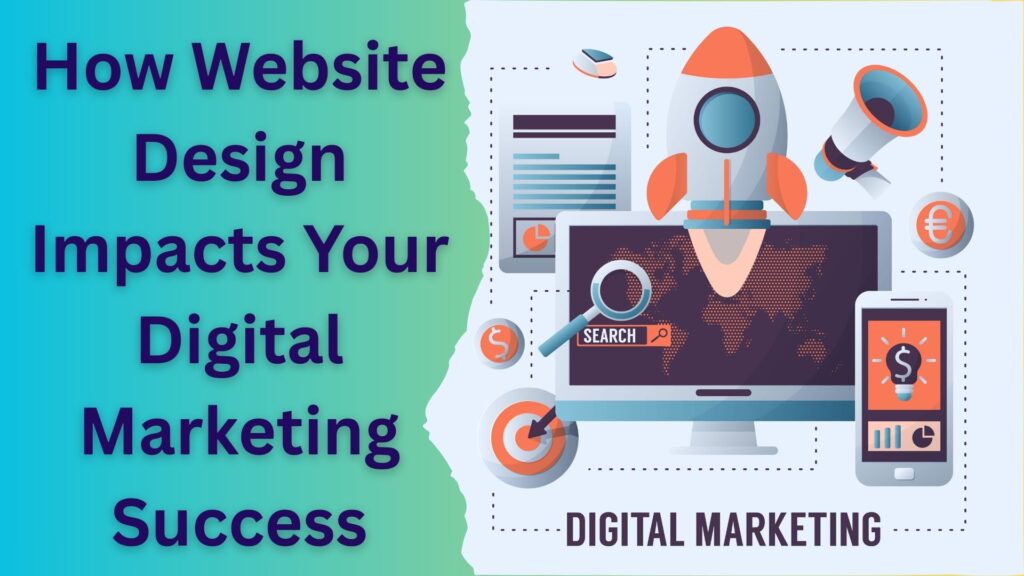In today’s digital world, your website is more than just an online brochure, it’s the base of your entire digital marketing strategy. Whether you’re a small business or a large corporation, your website design is key to how customers perceive your brand, interact with your content and make buying decisions.
Many businesses underestimate the power of design, but the truth is a bad designed website can undermine your marketing, lower your sales, and damage your credibility. Let’s dive in and see how website design impacts your digital marketing.
First Impressions Shape Brand Perception
Your website is often the first point of contact for your customers. Research shows visitors decide on a website in a matter of seconds. If your site appears outdated, cluttered, or difficult to navigate, visitors may leave before they even reach your products or services.
This is where website design in digital marketing comes in, because your marketing campaigns drive traffic to your site, but it’s your design that decides if visitors stay or bounce.
Tips: Clean layouts, consistent branding, and mobile responsiveness build trust and credibility.
Website Design Directly Affects User Experience
A website’s usability determines if visitors will stay, explore, or convert. How website design affects user experience is key to digital marketing success.
For example:
- If your site loads slowly, customers will leave.
- If your navigation is confusing, users won’t find what they need.
- If your design isn’t mobile-friendly, you’ll lose mobile traffic.
Since user experience (UX) is a Google ranking factor, bad design will also hurt your SEO rankings and reduce organic traffic.
Tip: Ensure your site loads within 3 seconds, features simple menus, and adapts to all devices.
Web Design and Content Marketing Go Hand in Hand
Content is king in digital marketing, blogs, videos, infographics, and landing pages. But how does web design impact content marketing? The answer is presentation.
Even great content won’t perform if it’s hard to read, hidden behind clutter, or poorly structured. A well-designed website ensures your content is beautiful, easy to consume, and optimised for conversions.
For example:
- Clear headings make it readable.
- Strategic whitespace makes it focused.
- Visual hierarchy points to calls to action.
When design and content marketing work together, businesses see higher engagement and better conversions.
The Connection Between Web Design and Sales
So businesses ask: how does website design impact sales? The answer is that design affects buying decisions at every stage of the customer journey.
- A good design builds trust, so visitors are more likely to buy.
- Product pages with a clear layout and visuals help with decision-making.
- Seamless checkout design reduces cart abandonment.
In short, a well-designed design doesn’t just bring in visitors, it converts them into paying customers.
Tip: Use persuasive design elements like testimonials, trust badges, and clear call-to-action buttons to boost sales.
SEO Benefits of Good Website Design
SEO success is all about visibility. If your website isn’t optimised for SEO, even the best campaigns won’t work.
Google looks at page speed, mobile friendliness and overall usability when ranking websites. A cluttered, slow or poorly coded design will hold you back and make it harder for customers to find you.
On the other hand, a well-structured, SEO friendly website will improve your ranking and maximise the impact of your digital marketing.
Enhancing Social Media and Paid Marketing Efforts
Your paid ads and social media campaigns send users to your website. If those landing pages aren’t well designed, your advertising dollars will be wasted.
Imagine clicking on a Facebook ad and landing on a messy, confusing page you’d bounce. A great design ensures every visitor arriving through social or paid campaigns finds a user-friendly, conversion-driven experience.
Mobile-First Design Is No Longer Optional
Over 50% of all internet traffic is mobile. A desktop-only site will frustrate users and lose you Google search ranking opportunities.
Mobile-friendly design improves user experience, keeps visitors engaged, and gets your digital marketing in front of the widest audience.
Website Design Builds Trust and Authority
Digital marketing works when customers trust your brand. A professional modern website design shows you’re credible, reliable, and customer-focused.
Visitors often equate the quality of your website with the quality of your services. A clean, secure, and user-friendly site tells them your business is legitimate and trustworthy.
Analytics and Conversion Optimization
Modern website design lets you track user behaviour, what pages they visit, how long they stay, and where they drop off. This data helps refine both design and marketing for better results.
For example, if analytics show users are abandoning the checkout page, it may be design, not marketing. Improve the layout, simplify the steps or add trust signals and the problem is solved.
Final Thoughts: Design as the Backbone of Digital Marketing
At the end of the day, digital marketing is about driving traffic, engaging audiences and converting leads. Website design impacts all of these.
- It makes first impressions.
- It affects user experience.
- It amplifies content marketing.
- It directly impacts sales and conversions.
In other words, your marketing may bring visitors, but your website design decides if they become customers.

